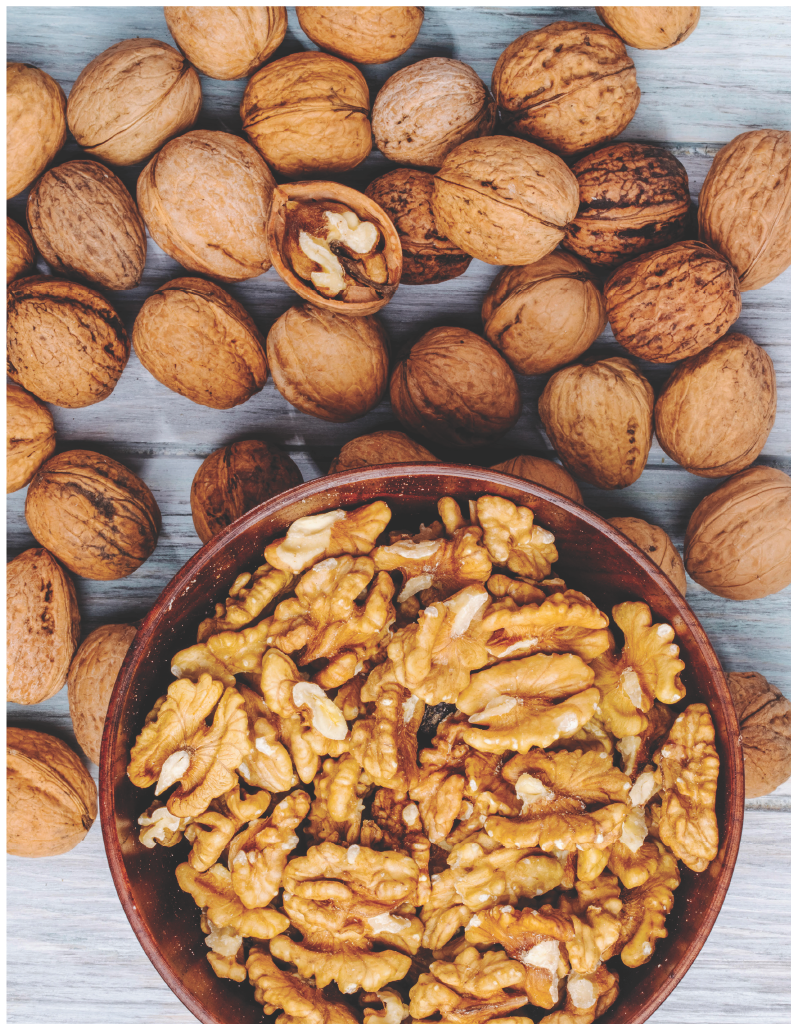Often called Carpathian or English walnuts, these common orchard trees are descended from parents in Southeast Europe and Southwest Asia. They are widely grown commercially and provide a valuable source of protein and other nutrients for consumption. Walnuts are relatively hardy, and do best in cold winter areas, but can be susceptible to hard early or late frosts. In Northern Utah, they are consistently one of the last trees to produce leaves in the spring. The tree grows quickly, up to 40-60 feet tall, and has an attractive, smooth, grey bark that covers the trunk and lower branches. Most walnut varieties are self-fruitful, but it is best to plant 2 varieties for cross pollination.
A common, yet untrue myth exists that walnut leaves are unsuitable to compost or work into garden soil. While it is true that all walnuts produce a natural toxin called juglone that can damage some crops, it breaks down very quickly in compost and even in well ventilated sunny areas. Do not hesitate to use them as carbon based organic matter for your compost pile. While Black walnuts retain the highest concentration of juglone, the leaves can also be composted and used after a few months.
As the nuts ripen and start to fall from the husks, watch for nut loving squirrels that will compete with even the best trained harvesters. Keep an eye out for these agile nut thieves in September and October.
Location
Open site in full sun, with good air circulation. Walnuts make great shade trees, and can handle growing in lawn or landscape locations
Soil
Deep garden, loamy soil works best - well drained, not soggy. Avoid heavy clay.
Planting
Space trees at 30-40 foot intervals. See attached bare root and container planting guide.
Water
Make sure to provide regular water throughout the growing season - usually a deep watering every 10- 15 days depending on heat and sun exposure. As walnuts mature and grow, they are large and sturdy enough to survive with little to no supplemental watering except during hot, dry summer conditions.
Fertilizer
Use a balanced fertilizer in early spring with micronutrients to maintain consistent growth and fruit production. We recommend Anderson’s Best: That’s All It Takes, Fertilome Fruit, Nut and Pecan food, or Natural Guard Organic Fruit and Citrus Fertilizer. A good rule of thumb is to use 1/2 to 1 pound of fertilizer per inch of trunk diameter (2 cups generally equals 1 pound). Spread fertilizer evenly around the drip line of the tree.
Pruning
Walnut trees grow tall and straight, so train them as a central leader with strong scaffold branches on 45 degree angles - be sure to remove any narrow or open angle crotches, as these are the weakest branches that will break with wind and snow. Thin out any dead or damaged branches each spring. Otherwise, minimal pruning is needed each year and will be adequate to maintain a healthy crop.
Harvest and Yield
In late September or early October, when ready for harvest, the nuts will fall from the husks and can be easily gathered up from the ground. Depending on the variety, some trees will drop the nuts, husk and all. These will have to be gathered and husked before drying. Dry the nuts until dry (crack one open and check the kernel for brittleness) in a warm, wellventilated, mostly shady location. Walnuts can keep in-shell for up to 2 months if stored in a cool, dry place; up to 6-12 months in a sealed container in a refrigerator. Each tree will usually produce 100-150 pounds of nuts depending on location, fertilizer, variety and rootstock.
Pests
Other than aphids, Walnut Husk Fly is the most common pest for walnuts. The fly attacks the husks, causing them to turn black and adhere to the shell. In most cases, the nuts fall prematurely from the tree. The damage stains the shells and makes the husks very difficult to remove, but normally does not damage the nut kernels inside. An application of a general-purpose insecticide like permethrin, or bifenthrin, under the canopy of the tree in mid-July and then again in early August will usually kill the flies as they hatch, and before they can damage the husks.
Otherwise, Walnuts are relatively pest and disease free in the Intermountain West.
Varieties
Walnut, Carpathian
Mature trees produce an average of 3-4 bushels of nuts. Prefers deep, dry, light loamy soils. Avoid wet or poor subsoil. Once established, these trees are very hardy and can survive temperatures as low as -30 degrees Fahrenheit with little or no die-off.
Zones: 5a-9
Height: 40-60'
Spread: 40-60'
Sun Exposure: Full Sun
Flavor: Sweet
Pollinator: Semi self-fertile. A second walnut is recommended
Cooking/Storage: Good for both
Bloom Period: Mid-Spring
Harvest Period: Fall, when nuts fall to the ground

